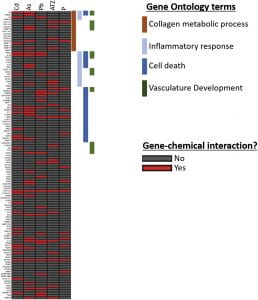PROTECT studies the impacts of environmental contamination on birth outcomes by following a cohort of pregnant women in Puerto Rico, where contamination is extensive and adverse birth outcomes such as preterm birth occur at high rates. Miscarriage, or early pregnancy loss prior to 20 weeks gestation, is the most common pregnancy complication, but is challenging to study. Many miscarriages occur before a participant would be recruited into a birth cohort study like PROTECT, and may even occur before a woman knows she is pregnant.
Given this, how can researchers assess the potential impacts of environmental contamination on miscarriage? Investigators from PROTECT Project 2tackled this question in a study published in Environmental Research in 2020. Using miscarriage and chemical gene lists from the Comparative Toxicogenomics Database (CTD), they set out to identify chemicals that could potentially increase the risk of miscarriage as well as the specific molecular targets and cellular pathways these chemicals impacted. Because pregnant women are exposed to mixtures of multiple chemicals—like everyone else alive today—researchers also identified which targets and pathways were commonly impacted by multiple chemicals.
Drawing on prior research by PROTECT Projects 1 and 3, the research team focused on 25 superfund chemicals typically found in Puerto Rico and in our cohort of participants. The team downloaded gene lists associated with miscarriage from the CTD as well as a list of “chemical-gene interactions” for each of the 25 chemicals. They then conducted statistical tests for each of the 25 chemicals to determine if they interacted with more genes involved in miscarriage than would be expected by random chance. In order to capture data from species most commonly used in toxicology studies, the team analyzed data obtained from human, mouse and rat species.

Chemical-gene interactions for 121 miscarriage genes and associations with Gene Ontology terms relevant to miscarriage (click to enlarge)
Results show that a broad range of chemicals, including metals, pesticides, volatile organic carbons, and polycyclic aromatic hydrocarbons, affected a significantly high number miscarriage genes in at least one of the three species tested (human, mouse, or rat). These results suggest that these exposures to these chemicals could lead to a bias in live birth cohorts, where those fetuses that are more susceptible to chemical exposures are lost prior to recruitment and are not included in the study. Thus, researchers need to be careful in accounting for these sources of potential bias.
Researchers also sought to investigate chemical impacts on biological pathways that might help to understand potential mechanisms for chemical effects on miscarriage. They investigated four Gene Ontology defined biological processes that are listed as phenotypes associated with miscarriage in the CTD: collagen metabolic process, inflammatory response, cell death, and vasculature development. Chemicals with significantly high numbers of interactions with “miscarriage genes” also impacted genes in one or more of these pathways.
Overall, the study adds to the body of evidence suggesting that exposure to certain chemicals may be a risk factor for miscarriage, and provides insight into the cellular pathways that are targeted by these chemicals.
